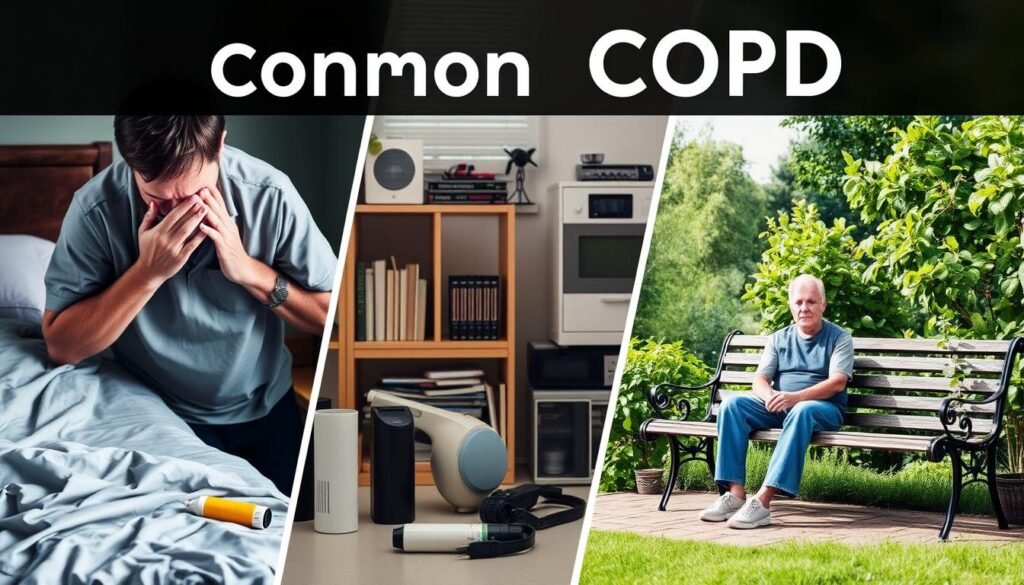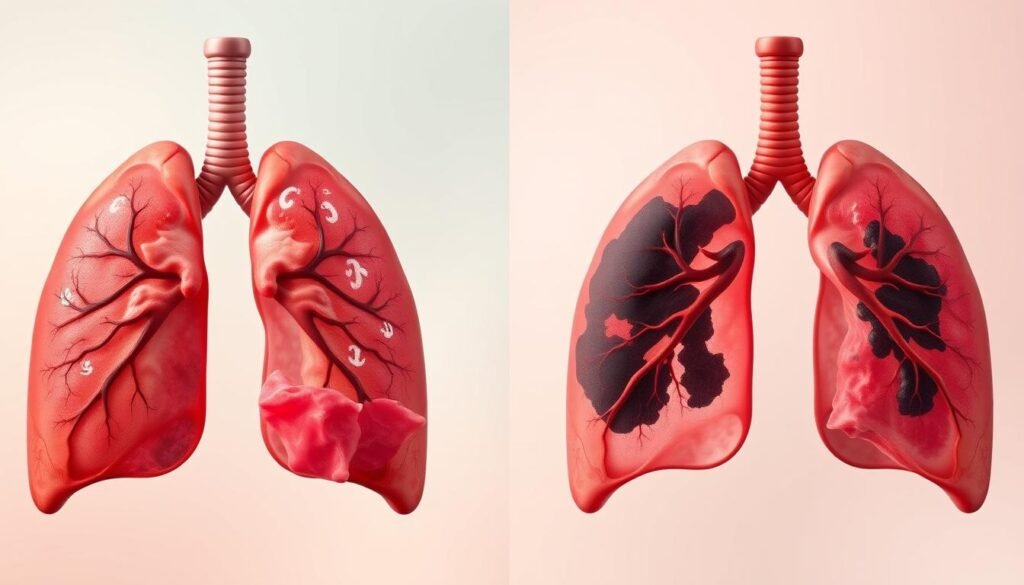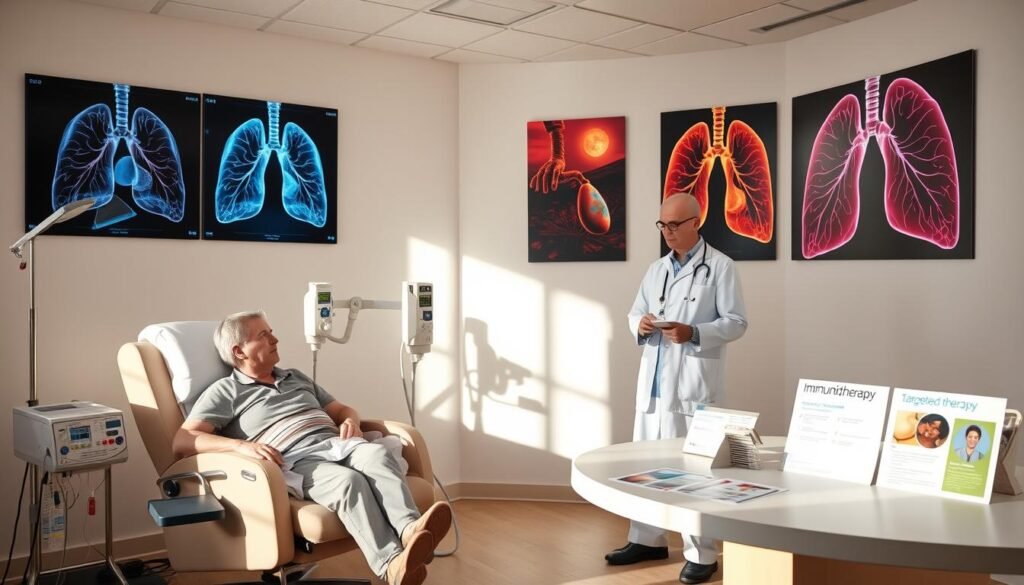Did you know that having COPD delays lung cancer diagnosis by about a month? This delay matters a lot. It can affect how well treatments work and overall health. It’s very important to know the differences and shared signs of COPD and lung cancer for quick action and better care.
Both COPD and lung cancer have similar symptoms, which can make telling them apart hard. For example, COPD might cause coughing up mucus and trouble breathing when active. Lung cancer symptoms might include a constant cough, chest pain, and not feeling hungry. We’re here to help make these complex conditions clearer by highlighting what sets them apart and what they share.
For detailed insights and guidance on understanding the connection between these conditions, visit this informative resource.
Key Takeaways
- Individuals with COPD are at an increased risk for developing lung cancer.
- Recognizing the differences in symptoms is vital for accurate diagnosis.
- COPD patients may experience a delay in lung cancer diagnosis compared to those without chronic conditions.
- Common symptoms of both conditions often overlap, complicating assessments.
- Timely medical advice is crucial for those with respiratory issues to catch lung cancer early.
Understanding Chronic Obstructive Pulmonary Disease (COPD)
Chronic obstructive pulmonary disease, known as COPD, is a long-lasting lung problem. It causes the lungs to get worse over time. Smoking is a big cause of COPD in many places, but bad air from cooking and heating is also harmful. Around 8–10% of adults worldwide have this disease, and it’s more common in smokers.
People with COPD face many symptoms that affect their life every day. The most common symptoms are:
- Difficulty breathing, especially when moving around
- A cough that doesn’t go away
- Getting a lot of colds and flu
Having trouble breathing can stop people from doing things they enjoy. It can also make them feel anxious or sad. Plus, if you have COPD, you’re more likely to get lung cancer. This is why it’s important for patients and doctors to know about it.
To manage COPD, healthcare plays a key role. Stopping smoking can really help slow down the disease. It also lowers the risk of having more health problems.
| Common COPD Symptoms | Impact on Quality of Life |
|---|---|
| Difficulty breathing | Limits physical activity and enjoyment of daily tasks |
| Chronic cough | Interferes with social interactions and sleep |
| Increased respiratory infections | Leads to frequent medical visits and hospitalizations |
COPD is a big concern for public health. Understanding this disease, its symptoms, and the importance of catching and stopping it early can reduce its effects on people and the health system.
What is Lung Cancer?
Lung cancer starts when lung cells turn cancerous and grow without control. This growth can create tumors. These tumors may invade nearby tissues and even spread to other body parts. There are two main kinds of lung cancer: small cell (SCLC) and non-small cell (NSCLC). NSCLC makes up about 85% of cases, while SCLC is about 15%.
There’s a scary link between lung cancer and COPD. Nearly 80% of lung cancer patients also have COPD. About 1% of people with COPD get lung cancer yearly. Having COPD means you’re much more likely to get lung cancer, up to five times more. Being older, having a lower BMI, and a long history of smoking increase this risk.
- Persistent cough
- Chest pain
- Unexplained weight loss
- Shortness of breath
- Frequent respiratory infections
It’s key to know these symptoms for early detection. COPD can hide or act like lung cancer signs. Because of this, people with COPD need to watch their health closely. Studies show COPD patients with lung cancer often have worse outcomes, especially with squamous cell tumors.
To understand this complex relationship, it’s important to seek more info. For additional details on COPD and lung cancer, visit this resource.
Key Differences Between COPD and Lung Cancer Symptoms
It’s crucial to tell the key differences between COPD and lung cancer symptoms apart. This helps in catching the condition early and treating it effectively. While they share some signs, each has unique symptoms that set them apart.
COPD and lung cancer both can cause a cough. But, the cough from COPD is often wet and comes with more mucus. On the other hand, lung cancer’s cough might be drier and can include blood. This is a sign there’s likely no mucus.
Both conditions make breathing tough. People with COPD usually feel it when they’re active. But, those with lung cancer can have trouble breathing even when still. Spotting these signs is key to telling COPD from lung cancer apart.
Chest pain also feels different. Lung cancer might cause pain in a specific spot that gets worse when you breathe deeply. Meanwhile, COPD makes your chest feel tight but not sharply painful. This is how chest pain varies between them.
Unexpected weight loss is another alarming sign but mostly in lung cancer. It’s not common in COPD until it’s very advanced. This difference is important to understand and keep track of.
Knowing the difference between symptoms of COPD and lung cancer leads to better diagnosis and faster treatment. There’s extra info, like a guide on lung cancer signs, that can make you more alert. For more details, check out this informative resource.
Common Symptoms of COPD
Chronic obstructive pulmonary disease (COPD) has several common symptoms that greatly affect daily life. Some of the most common are chronic cough, which often produces mucus, and wheezing, a high-pitched noise heard when breathing.
These symptoms can make it harder to do physical activities. Besides chronic cough and wheezing, people may feel short of breath, also known as dyspnea. This feeling can get worse during exercise or even simple daily tasks, leading to tiredness and frustration.
As COPD gets worse, the symptoms can become more severe and happen more often. It’s very important to keep an eye on these symptoms. Recognizing when they worsen can help you seek medical help sooner, which can improve life quality.
The following table shows the main symptoms often seen with COPD:
| Symptom | Description |
|---|---|
| Chronic Cough | A persistent cough that brings up mucus. |
| Wheezing | A high-pitched sound heard while breathing. |
| Shortness of Breath | Feeling out of breath, mainly when active. |
| Chest Tightness | Feeling like there’s pressure or tightness in the chest. |
Recognizing and managing these symptoms early is crucial to improve life for those with COPD. If you’re experiencing these symptoms, it’s important to talk to healthcare professionals. They can offer treatments and ways to manage these symptoms.

Common Symptoms of Lung Cancer
Lung cancer affects lung function and overall health deeply. Many do not notice symptoms until the cancer spreads. But, spotting signs early can lead to better treatment.
A persistent cough is a key sign of lung cancer symptoms. This cough may get worse over time. Other signs include chest pain, coughing up blood, hoarseness, and losing weight without trying.
Unexplained weight loss is a serious sign. It can happen when the body fights cancer cells. Trouble breathing might also mean lung cancer, especially if a tumor blocks air or fluids build up in the lungs.
Signs like constant infections, feeling very tired, or starting to wheeze are important too. They urge a need for a check-up. Spotting these early helps fight lung cancer better.
Want to know more about lung cancer symptoms and back pain? Check this helpful guide.
Comparing COPD vs Lung Cancer Symptoms
It’s important to know the difference between COPD and lung cancer symptoms. Both conditions have similar symptoms which can confuse people. Knowing the differences helps make better health decisions.
Shared Symptoms
People with COPD and lung cancer often cough a lot and have trouble breathing. These symptoms affect their daily lives. It’s important to see a doctor if you have these symptoms. Other shared symptoms include:
- Fatigue
- Wheezing
- Chest discomfort
Noticing these symptoms early can lead to a quicker diagnosis. Early treatment can lead to better health outcomes. For treatment options, click here.
Differentiating Key Signs
Though COPD and lung cancer share symptoms, some signs are specific to each. Blood in sputum often points to lung cancer, whereas wheezing is usually seen in COPD. Chest or shoulder pain that’s new and constant might indicate lung cancer. Recognizing these signs early is crucial for effective treatment.

The Connection Between COPD and Lung Cancer
The link between COPD and lung cancer is closely studied in respiratory health. COPD doesn’t directly cause lung cancer, but it raises the risk. This is because they share risks like smoking and lung inflammation. Chronic inflammation in COPD patients may lead to cellular changes that cause cancer. Knowing how these conditions interact is vital.
COPD’s impact is huge. Prevalence ranges from 7.8% to 19.7% in specific areas. COPD is set to become the third leading cause of death by 2020. Lung cancer caused about 1.37 million deaths globally in 2008. For those with COPD, lung cancer deaths vary from 4% to 33%. People with airflow problems have an 8.8% chance of getting lung cancer in ten years. This is compared to 2.0% for those without.
A drop in FEV1 heightens lung cancer risk, especially in women. CT scans of emphysema show a lung cancer risk factor between 1.9 to 4.7. The adjusted odds of lung cancer when emphysema is detected by CT range from 1.73 to 3.14. Thus, it’s important to watch and manage COPD because of its link to lung cancer.
Smoking is a top risk factor. From 2000 to 2004, about 443,000 U.S. adults died from smoking-related diseases, including lung cancer. The chance for smokers to get lung cancer is high—17.2% for men and 11.6% for women. For smokers with COPD, the risk of lung cancer is up to five times higher than those with healthy lungs.
It’s crucial to understand the COPD-lung cancer link for patient care. Lowering COPD risks and taking preventive steps can cut lung cancer chances.
For more detailed insights into this subject, visit this study.
Diagnosis and Testing for COPD and Lung Cancer
Knowing the difference between COPD and lung cancer is key. For COPD, tests look at how well lungs work. Spirometry is the main test, which checks airflow to see if COPD is present. Other tests like pulmonary function tests, blood work, and X-rays help doctors get a full picture.
Lung cancer needs closer inspection to diagnose. It involves CT scans and biopsies to spot abnormalities and confirm cancer. Those with COPD need regular lung cancer checks. Catching it early makes treatment more successful.
A strong link exists between lung cancer and COPD. More than half of lung cancer patients also have COPD. Research shows that people with COPD are more likely to find lung cancer early. This is why good lung cancer screening is crucial for them. Getting diagnosed early means a better chance of beating lung cancer, especially for those with COPD.
| Diagnosis Method | COPD | Lung Cancer |
|---|---|---|
| Spirometry | Yes | No |
| CT Scans | No | Yes |
| Biopsies | No | Yes |
| Chest X-rays | Yes | Yes |
| Blood Tests (e.g., alpha-1-antitrypsin deficiency) | Yes | No |
Keeping a close eye on COPD and lung cancer is crucial. Regular lung cancer screenings for those with COPD can lead to earlier detection. Early discovery means better treatment options and outcomes.
Treatment Options for COPD
Treatment for COPD helps reduce symptoms and lower the chances of flare-ups. It also improves your ability to enjoy life. Every person needs a custom treatment plan based on their symptoms and health. COPD can’t be cured, but treatment focuses on managing symptoms, slowing the disease, and enhancing life quality.
- Medication: Doctors often prescribe bronchodilators and inhaled corticosteroids. These make breathing easier by relaxing the airways.
- Lung therapies: Pulmonary rehab programs teach exercises and breathing techniques to strengthen the lungs.
- Lifestyle modifications: Stopping smoking is key. It greatly cuts the risk of serious flare-ups and slows the disease’s progress.
It’s critical not to use over-the-counter portable oxygen concentrators. They might not provide the oxygen levels your doctor has prescribed. For guidance and more information, you can call the Lung HelpLine at 1-800-586-4872.
Treatment Options for Lung Cancer
Treatment for lung cancer is tailored to fit the disease’s complexity. There are many ways to fight it: surgery, chemo, radiation, and immunotherapy. Catching it early boosts the chance of beating it.
Surgery aims to take out tumors and can vary in intensity. It might be as simple as removing a small part of the lung. Or, it could involve taking out a whole lung lobectomy or pneumonectomy. Post-surgery, chemo may be needed to get rid of any left-over cancer cells.

Radiation therapy is key for lung cancer treatment. It’s especially useful for small cancers or when surgery isn’t an option. By focusing the radiation, it does less harm to healthy tissue. Another approach is targeted therapy, attacking cancer cells’ unique traits.
Immunotherapy offers new hope, boosting the body’s fight against cancer. For pain and symptom relief, palliative care is available. This care focuses on improving life quality and can even extend it during tough treatments.
| Treatment Type | Purpose | Notes |
|---|---|---|
| Surgery | Remove tumors | Includes wedge resection, lobectomy, and pneumonectomy |
| Chemotherapy | Eliminate remaining cancer cells | Often administered post-surgery |
| Radiation Therapy | Targeted cancer treatment | Stereotactic body radiotherapy is common for inoperable cancers |
| Immunotherapy | Boost immune response against cancer | Helps the body fight cancer more effectively |
| Palliative Care | Symptom relief | Improves quality of life alongside other treatments |
Choosing the best treatment mix needs expert advice. It depends on the cancer’s stage and the patient’s health. Talking openly with doctors is key to get the best results from lung cancer treatment.
Importance of Early Detection and Monitoring
Finding lung cancer early and keeping an eye on it can really help patients do better. People with COPD or who might get lung cancer should get checked early. This can find problems quickly. Screenings are very important and have been shown to save lives. Catching lung cancer early, especially with low-dose CT scans, greatly improves chances of survival. In fact, with early detection, more than 85% of people can live over 10 years.
Chronic diseases like COPD can be confusing because symptoms vary a lot. This confusion can delay treatment. About 14 million Americans have COPD but haven’t been diagnosed. Regular checks help find those at risk early. This can stop things from getting worse. Advanced tests are needed because standard tools may not find the disease early on.
When people notice symptoms early, they can really benefit from looking after their lung health. Getting checked regularly helps people be more aware of their lung health. For those already facing lung issues, getting advice tailored to their specific risks can help catch things early. New tech is improving how we track lung health, giving key info on how lungs are changing.
Adding lung cancer checks to regular health care can change outcomes a lot. Interestingly, 67% of people diagnosed with COPD during screenings didn’t know they had it. This shows the huge need for constant monitoring. Patients and doctors need to work together to make sure lung health is always considered. This can lessen the risk of finding out about lung problems too late.
Screenings are crucial for catching lung cancer early and watching for COPD carefully. People need to stand up for their health, asking for full checks and watching their symptoms closely. In the end, getting checked often and monitored well is key to fighting chronic respiratory diseases.
Conclusion
It’s very important to know the symptoms of COPD and lung cancer early on. Understanding their relationship is key to catching them quickly. If you have breathing problems, talk to your doctor for a full check-up.
Spotting these diseases early can really help those at risk. Many people show signs of both COPD and lung cancer, studies show. By getting regular checks and following doctor’s advice, patients can live better and avoid bigger health issues.
Teaching people about COPD and lung cancer is crucial for better tests and learning. These diseases can greatly affect someone’s life. Knowing the symptoms and acting early is the first step towards better lung health.